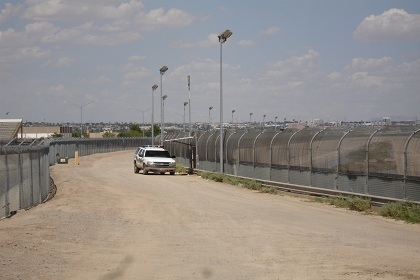Long U.S.-Mexican Border Defies Attempts to Close It Off

AFP
Central American migrants who ran into walls of security personnel, razor wire and tear gas at the US border in Tijuana, Mexico on Sunday chose possibly the hardest place to pass.
Just a few miles (kilometers) away high walls and dense patrolling give way to relatively easily scaled fencing. But even then, they would have faced rugged terrain and a stepped-up presence by U.S. Border Patrol agents.
The 2,000 mile (3,200 kilometer) border from the Pacific Ocean to the Gulf of Mexico has long defied efforts to seal it off, due to a mix of politics and sheer geography.
In the 12 months to September 30, the U.S. Customs and Border Protection apprehended or blocked 521,090 people from entering the country illegally. There are no good estimates of how many get through, but it is likely hundreds per day.
President Donald Trump has demanded the whole border be fenced, a near-impossible task.
Since 2006 the government has fenced off around 700 miles with vehicle barriers and fences, from eight to 30 feet (2.4 meters-9.1 meters) high.
Nearly all of that is in three states: California, New Mexico and Arizona, where the border is relatively straight and most of the land on the U.S. side is government-owned.
The longest stretch, the Mexico border with Texas, is marked by the sinuous Rio Grande River, whose loops and bights make a border-hugging fence impractical. Moreover, most of the land along the border is privately owned, and many landowners object to fencing off their property from the river.
In addition, in some urban areas there is heavy traffic by people who cross the border every day for school, work and family business.
- Into a no-man's land -
Nevertheless, at the beginning of 2018 Trump demanded Congress budget $25 billion to fence the entire border.
So far $1.6 billion has been allocated for new walls to be constructed in two areas with the heaviest populations.
One is at Tijuana, Mexico, where the caravan of several thousand Central American migrants is trying to pass to the San Diego, California area on the north side.
That is already one of the most difficult sections of the border to cross successfully, with two and sometimes three parallel fences, now reinforced with razor wire.
The 42 people U.S. officials said were arrested Sunday crossing the border only breached a primary fence into a kind of no-man's-land on the US side, never reaching a second fence.
The second section being reinforced under Trump's wall program is the Rio Grande Valley, the easternmost stretch of the border near McAllen, Texas.
In between are large areas with no effective barriers. But searing deserts, towering mountains and brutal drug smugglers make passage a highly risky undertaking.
Increasingly, too, instead of walls the U.S. has installed border lights and cameras and deployed drones for monitoring, increasing the chance of being caught.
Latest News
 Safadi, Iranian counterpart discuss war on Gaza, regional escalation
Safadi, Iranian counterpart discuss war on Gaza, regional escalation US vetoes Security Council resolution on full Palestinian UN membership
US vetoes Security Council resolution on full Palestinian UN membership King, Bahrain monarch stress need to maintain Arab coordination
King, Bahrain monarch stress need to maintain Arab coordination Security Council to vote Thursday on Palestinian state UN membership
Security Council to vote Thursday on Palestinian state UN membership Dubai reels from floods chaos after record rains
Dubai reels from floods chaos after record rains
Most Read Articles
- Jordan urges UN to recognise Palestine as state
- Senate president, British ambassador discuss strategic partnership, regional stability
- Temperatures to near 40 degree mark next week in Jordan
- JAF carries out seven more airdrops of aid into Gaza
- Safadi, Iranian counterpart discuss war on Gaza, regional escalation
- US vetoes Security Council resolution on full Palestinian UN membership
- UN chief warns Mideast on brink of ‘full-scale regional conflict’
- Biden urges Congress to pass 'pivotal' Ukraine, Israel war aid
- Google fires 28 employees for protesting $1.2 billion cloud deal with “Israeli” army
- Israeli Occupation strike inside Iran responds to Tehran's provocation, reports say